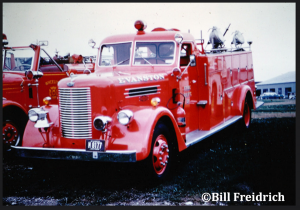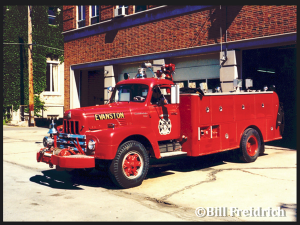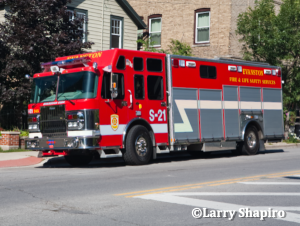From Phil Stenholm:
Another installment about History of Evanston Fire Department
MOTORIZATION
During 1916, Evanston’s firefighting force was increased to 39, as four additional firemen were assigned to Station # 1. The Evanston Fire Department was also growing increasingly experienced, as 18 of the 39 members of the EFD (46%) had 10+ years of experience by this point in time, including all of the chiefs and company officers. Annual EFD salaries in 1916 ranged from $1,800 (Chief Fire Marshal) to $1,200 (Assistant Chief Fire Marshal) to $1,140 (Captain, Motor Driver, and Engineer) to $1,080 (Lieutenant, Assistant Motor Driver, and Assistant Engineer) to $1,050 (Fireman I) to $840 (Fireman II).
The National Board of Fire Underwriters (NBFU) conducted an inspection of the Evanston Fire Department in 1916, and issued its report in October. The NBFU advised the City of Evanston to either completely motorize its fire department immediately, or else build a fourth fire station to provide fire protection for the west-side of the city. Failure to do one or the other would almost certainly result in significantly higher fire insurance premiums for Evanston property owners and businesses.
EFD Chief Albert Hofstetter enthusiastically supported the NBFU’s recommendation, claiming that complete motorization of the fire department would both cut maintenance costs by 50% – AND – improve response times to areas of the city not in close proximity to a fire station.
Alderman H. E. Chandler proposed that Evanston place automobile firefighting apparatus in service at all three fire stations ASAP, and the city council responded on February 20, 1917, by authorizing the issuance of $30,000 in bonds to pay for full motorization of the EFD, pending approval by voters in the upcoming election. The bond issue was subsequently approved by Evanston voters on April 3rd, and the city immediately advertised for bids.
Chief Hofstetter listed the automobile firefighting apparatus to be purchased:
FOR FIRE STATION # 1:
1. A city service ladder truck equipped with a 55-foot ground-based rapid extension ladder that could be raised by four men using tormentor poles, ten other ladders of various types and lengths including pompier ladders and roof ladders, salvage covers, pike poles, axes, rope, and buckets, a 50-gallon chemical tank with a red-line hose reel, six hand extinguishers of various types, a heavy-duty jack capable of lifting ten tons, and a life net, replacing the ex-Chattanooga F. D. horse-drawn 1891 LaFrance / Hayes 55-ft HDA (Truck 1) that was being leased from American-LaFrance and the horse-drawn 1873 Babcock double 50-gallon chemical engine (Chemical 1);
2. A 750-GPM triple-combination pumper equipped with one 35-foot ground ladder and one 25-foot ground ladder, a 50-gallon chemical tank with a red-line hose-reel, and six hand fire extinguishers of various types, replacing the 1911 Robinson Jumbo triple-combination pumper (Motor Engine 1) that was to be transferred to Station # 3 and replace the horse-drawn 1895 Ahrens Metropolitan 600 GPM second-size steamer (Engine 3).
FOR FIRE STATION # 2:
1. A one-axle tractor to be welded to the 1906 American-LaFrance Metropolitan 700-GPM second-size steamer (Engine 2) after removal of the steamer’s three-horse hitch;
2. A chemical engine & hose truck equipped with one 35-foot ground ladder and one 25-foot ground ladder, a 50-gallon chemical tank with a red-line hose reel, and six hand fire extinguishers of various types, replacing the horse-drawn 1902 Seagrave chemical engine & ladder combination truck / hose tender (Truck 2).
FOR FIRE STATION # 3:
1. A chemical engine & hose truck equipped with one 35-foot ground ladder and one 25-foot ground ladder, a 50-gallon chemical tank with a red-line hose reel, and six hand fire extinguishers of various types, replacing the horse-drawn 1885 Davenport H&L / hose-tender (Truck 3).
The twelve horses that were still in service with the EFD in 1917 were to be retired, sold, or transferred to the street department as soon as the automobile apparatus were placed into service, although two, horse-drawn rigs – the 1895 Ahrens Metropolitan steamer and one of the 1901 four-wheeled hose wagons — would be kept in reserve, albeit with no EFD horses left to pull them.
In the event that one or both of the reserve horse-drawn rigs would need to be placed into service, it was understood that former EFD horses in service with the street department would be temporarily transferred back to the EFD. For that same reason, the stables and hay lofts located in the three fire stations would need to be maintained for as long as horse-drawn apparatus remained in reserve.
Only two companies – American-Lafrance and Seagrave – offered bids, and on May 1st the Evanston City Council announced that the Seagrave Corporation had been awarded the contract, with a winning bid of $28,800. With the left-over funds, a new chief’s buggy — a 1917 Haynes touring car — was purchased, and the 1914 Overland roadster was sold.
As part of its bid, Seagrave offered to install 300-GPM “booster pumps” (as they were called) on the two chemical & hose trucks free-of-charge, and — as was common practice at the time — assign a company engineer to Evanston to provide driver training, instruction in vehicle maintenance and pump operations, and be available 24 / 7 to make any mechanical adjustments or repairs that might be needed as the rigs were being placed into service. Replacing the leased HDA (Truck 1) was deemed the highest-priority, so Seagrave promised to build the city service truck first. The estimated delivery date was November 1917, with the other rigs to be delivered somewhat later.
As to why Evanston opted to buy a city service truck instead of an aerial-ladder truck, the master-plan had been to eventually purchase an automobile tractor for the 1907 American-LaFrance 85-foot HDA, but then it was demolished in September 1916. Granted a ground-based 55-foot extension-ladder was very heavy and required more manpower to raise than was the case with an aerial ladder of a similar length, an extension ladder cost about 50% less than an aerial ladder, and it just would not have been possible to fully motorize the EFD in 1917 for $30,000 if a new tractor-drawn aerial ladder truck (TDA) was part of the order.

































